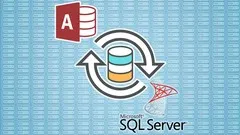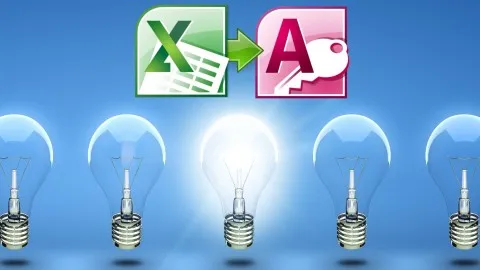
Free Microsoft Access Tutorial - Intro to Access - Microsoft Access Basics for Beginners 
This free course provides an introduction to Microsoft Access, guiding beginners through the basics of creating their first database. Learn the fundamentals of Access and take the intimidation out of the process. ▼
ADVERTISEMENT
Course Feature
![]() Cost:
Cost:
Free
![]() Provider:
Provider:
Udemy
![]() Certificate:
Certificate:
No Information
![]() Language:
Language:
English
![]() Start Date:
Start Date:
Self Paced
Course Overview
❗The content presented here is sourced directly from Udemy platform. For comprehensive course details, including enrollment information, simply click on the 'Go to class' link on our website.
Updated in [March 06th, 2023]
This course is designed to help beginners learn the basics of Microsoft Access. It covers the dashboard, tools, ribbon, tables, queries, forms, and reports. By the end of the course, learners will be able to create a simple database from scratch.
Possible Development Paths:
Learners who complete this course can use their newfound knowledge to pursue a career in database management. They can also use Access to develop more complex databases and applications. Additionally, they can use Access to create reports and forms for their own business or organization.
Learning Suggestions:
To get the most out of this course, learners should have a basic understanding of computers and databases. Additionally, they should be familiar with the Microsoft Office suite. Learners should also consider taking courses in SQL and other database programming languages to further their knowledge. Finally, they should practice using Access to create their own databases and applications.
[Applications]
At the end of this course, learners will be able to apply their knowledge of Microsoft Access to create a database from scratch. They will be able to use the dashboard, tools, and ribbon in Access to create tables, queries, forms, and reports. Additionally, they will be able to use Access to generate queries, forms, and reports. With this knowledge, learners will be able to create and manage databases for their own projects.
[Career Paths]
1. Database Administrator: Database Administrators are responsible for the design, implementation, maintenance, and security of an organization’s databases. They ensure that the databases are running efficiently and securely, and they are also responsible for troubleshooting any issues that arise. With the increasing demand for data-driven decision making, the demand for Database Administrators is expected to grow significantly in the coming years.
2. Data Analyst: Data Analysts are responsible for analyzing data to identify trends and patterns, and then using that information to make informed decisions. They use a variety of tools and techniques to analyze data, such as statistical analysis, machine learning, and data mining. With the increasing demand for data-driven decision making, the demand for Data Analysts is expected to grow significantly in the coming years.
3. Business Intelligence Developer: Business Intelligence Developers are responsible for developing and maintaining business intelligence systems. They use a variety of tools and techniques to create and maintain data warehouses, data marts, and other data-driven systems. With the increasing demand for data-driven decision making, the demand for Business Intelligence Developers is expected to grow significantly in the coming years.
4. Data Scientist: Data Scientists are responsible for analyzing large amounts of data to identify patterns and trends. They use a variety of tools and techniques to analyze data, such as machine learning, statistical analysis, and data mining. With the increasing demand for data-driven decision making, the demand for Data Scientists is expected to grow significantly in the coming years.
[Education Paths]
1. Bachelor of Science in Computer Science: This degree path focuses on the fundamentals of computer science, such as programming, software engineering, and computer architecture. It also covers topics such as artificial intelligence, data structures, and algorithms. With the increasing demand for technology in the workplace, this degree path is becoming increasingly popular and is a great way to gain the skills needed to work with Microsoft Access.
2. Bachelor of Science in Information Technology: This degree path focuses on the application of technology to solve problems. It covers topics such as database management, web development, and network security. With the increasing demand for technology in the workplace, this degree path is becoming increasingly popular and is a great way to gain the skills needed to work with Microsoft Access.
3. Master of Science in Information Systems: This degree path focuses on the management of information systems and the development of new technologies. It covers topics such as data mining, software engineering, and system design. With the increasing demand for technology in the workplace, this degree path is becoming increasingly popular and is a great way to gain the skills needed to work with Microsoft Access.
4. Master of Science in Computer Science: This degree path focuses on the fundamentals of computer science, such as programming, software engineering, and computer architecture. It also covers topics such as artificial intelligence, data structures, and algorithms. With the increasing demand for technology in the workplace, this degree path is becoming increasingly popular and is a great way to gain the skills needed to work with Microsoft Access.
Pros & Cons

Easy to follow step by step instructions.

Obtain basic proficiency quickly.

Clear introduction to basics of Access.

Quick and easy to understand.

Excellent communication skills of instructor.

A little simplistic.

Intimidating for new person.

Fundamental info only.

Pleasent voice only.

Not suitable for advanced learners.
Course Provider

Provider Udemy's Stats at AZClass
Discussion and Reviews
0.0 (Based on 0 reviews)
Explore Similar Online Courses

Complete Fitness Trainer Certification: Beginner To Advanced

Academic Writing Made Easy

Python for Informatics: Exploring Information

Social Network Analysis

Introduction to Systematic Review and Meta-Analysis

The Analytics Edge

DCO042 - Python For Informatics

Causal Diagrams: Draw Your Assumptions Before Your Conclusions

Whole genome sequencing of bacterial genomes - tools and applications

Upsize Your MS Access Business Information to MS SQL Server

Intro to Access - Microsoft Access Basics for Beginners

Excel to Access: Intro to Microsoft Access for Excel Users
 Related Categories
Related Categories
Quiz
 Submitted Sucessfully
Submitted Sucessfully
1. What will you be able to do at the end of this course?
2. What is the purpose of a Form in Access?
3. What is the purpose of a Report in Access?


Start your review of Free Microsoft Access Tutorial - Intro to Access - Microsoft Access Basics for Beginners